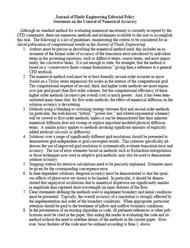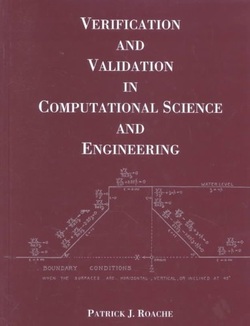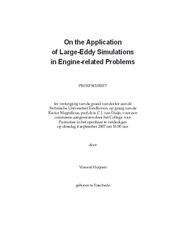Grid Sensitivity Issue
If you are writing a thesis for your master or PhD relating to the use of a CFD code to an engineering application or to any other application then it is required from you to conduct a grid sensitivity test, the following document provides the required guidelines by the Journal of Fluids Engineering Editorial Policy Statement on the Control of Numerical Accuracy:
''The Journal of Fluids Engineering will not consider any paper reporting the numerical solution of a fluids engineering problem that fails to address the task of systematic truncation error testing and accuracy estimation. Authors should address the following criteria for assessing numerical uncertainty.
1. The basic features of the method including formal truncation error of individual terms in
the governing numerical equations must be described.
2. Methods must be at least second order accurate in space.
3. Inherent or explicit artificial viscosity (or diffusivity) must be assessed and minimized.
4. Grid independence or convergence must be established.
5. When appropriate, iterative convergence must be addressed.
6. In transient calculations, phase error must be assessed and minimized.
7. The accuracy and implementation of boundary and initial conditions must be fully explained.
8. An existing code must be fully cited in easily available references.
9. Benchmark solutions may be used for validation for a specific class of problems.
10. Reliable experimental results may be used to validate a solution.''
1. The basic features of the method including formal truncation error of individual terms in
the governing numerical equations must be described.
2. Methods must be at least second order accurate in space.
3. Inherent or explicit artificial viscosity (or diffusivity) must be assessed and minimized.
4. Grid independence or convergence must be established.
5. When appropriate, iterative convergence must be addressed.
6. In transient calculations, phase error must be assessed and minimized.
7. The accuracy and implementation of boundary and initial conditions must be fully explained.
8. An existing code must be fully cited in easily available references.
9. Benchmark solutions may be used for validation for a specific class of problems.
10. Reliable experimental results may be used to validate a solution.''
Some Online Sites Dealing with Verification Issues
The following link also has some useful tips: http://www.innovative-cfd.com/verification-and-validation-main.html
References Relating to Grid Sensitivity
A recommended book is by Peter Roache's classic text on "Computational Fluid Dynamics" and ''Verification and Validation in Computational Science and Engineering''.
Another reference is the following one it studies the mixing process of two domains: http://mixing14.eu/p/mixing14eu_31.pdf
Another good publications is titled :THE ISSUE OF NUMERICAL UNCERTAINTY by Christopher J. FREITAS it can be obtained through the following link:
http://www.cfd.com.au/cfd_conf99/papers/084FREI.PDF
http://www.cfd.com.au/cfd_conf99/papers/084FREI.PDF
Recommened Thesis Links
The following provided link shows the use of LES in vehicle combustion chambers, it also presents the validation process to the reader, this thesis might be of good use to the researcher in providing hints to write a good thesis : http://alexandria.tue.nl/extra2/200711655.pdf
Grid Sensitivity Questions?
How is this done? The basic features of the method including formal truncation error of individual terms in
the governing numerical equations must be described. The indvidual trems mentioned do they represnt velocity scalar quantities, can the researcher rely on the convergance plots after the simulation has finished, this is for both a steady or an un-steady case.
the governing numerical equations must be described. The indvidual trems mentioned do they represnt velocity scalar quantities, can the researcher rely on the convergance plots after the simulation has finished, this is for both a steady or an un-steady case.
What if I am using a comerical software? An existing code must be fully cited in easily available references. Dose this mean if the software is a comercial code, the user can site the code manual as the source and can extract the required material of equations and essential theory from it.
What is this and how? Inherent or explicit artificial viscosity (or diffusivity) must be assessed and minimized. What is the explicit artificial viscosity? and why is it important?
This link talks about artificial viscosity: http://www.astro.uu.se/~bf/course/numhd_course/2_5_2Artificial_viscosity.html
This link talks about artificial viscosity: http://www.astro.uu.se/~bf/course/numhd_course/2_5_2Artificial_viscosity.html
When appropriate, when is it appropriate?, iterative convergence must be addressed, iterative convergance can be obtained from the iteration graphs shown during the calculation process.
How can this be done? The accuracy and implementation of boundary and initial conditions must be fully explained.
In transient calculations, where can these kinds of errors can be visulized? phase error must be assessed and minimized.
Benchmark solutions? A standard by which solutions can be measured or judged.
Second order accurate methods in space? How do I verfiy that the used method is second order accurate in space? do I just extract that type of information from the code user manual.
How to find grid independence or convergence must be established?
http://www.edsl.myzen.co.uk/downloads/misc/3D%20CFD%20Scaling%20Grid%20Independence%20Test.pdf
http://www.grc.nasa.gov/WWW/wind/valid/tutorial/spatconv.html
http://www.computationalfluiddynamics.com.au/convergence-and-mesh-independent-study/
http://zjw.public.iastate.edu/photos/stanford/HABASHI_MESH.pdf
http://memo.cgu.edu.tw/hsiu-po/CFD/Note%203.pdf
http://me.ucsb.edu/~pathirana/Other%20websites/Bajateam%20website/main_results_meshindependence.html
http://etheses.nottingham.ac.uk/91/1/TongYangThesis2004.pdf
http://www.edsl.myzen.co.uk/downloads/misc/3D%20CFD%20Scaling%20Grid%20Independence%20Test.pdf
http://www.grc.nasa.gov/WWW/wind/valid/tutorial/spatconv.html
http://www.computationalfluiddynamics.com.au/convergence-and-mesh-independent-study/
http://zjw.public.iastate.edu/photos/stanford/HABASHI_MESH.pdf
http://memo.cgu.edu.tw/hsiu-po/CFD/Note%203.pdf
http://me.ucsb.edu/~pathirana/Other%20websites/Bajateam%20website/main_results_meshindependence.html
http://etheses.nottingham.ac.uk/91/1/TongYangThesis2004.pdf
Unless otherwise noted, all content on this site is @Copyright by Ahmed Al Makky 2012-2013 - http://cfd2012.com




